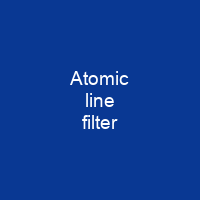Understanding Atomic Line Filters (ALFs): The Key to Precision Optical Filtering
Imagine a world where light can be filtered with such precision that it’s like separating the purest crystal from a murky pond—this is exactly what atomic line filters (ALFs) do. These sophisticated optical band-pass filters are used in scientific applications requiring the detection of narrowband signals, and they operate via absorption or resonance lines of atomic vapors.
The Evolution of Atomic Line Filters
Atomic line filters have a rich history dating back to the 1950s with the development of infrared quantum counters. Over time, these devices evolved into what we now know as ALFs, thanks to advancements in materials and design. They can operate across various spectral regions and are calculated by computers for specific applications, making them indispensable tools in scientific research.
Types of Atomic Line Filters
There are three major types of atomic line filters: absorption-re-emission filters, Faraday filters, and Voigt filters. Each type has its unique characteristics and uses:
- Absorption-re-emission filters: These absorb the desired wavelength and emit light that bypasses broadband filters.
- Faraday filters: They use the Faraday effect to rotate the polarization of light passing through a vapor cell near its atomic absorption lines. The rotation is proportional to the strength of the magnetic field, width of the vapor cell, and Verdet constant of the vapor.
- Voigt filters: These are similar to Faraday filters but with their magnetic fields shifted at 45° to the polarization of the polarized plates. The vapor cell acts as a half-wave plate in this setup.
Efficiency and Applications of Atomic Line Filters
The efficiency of atomic line filters is remarkable, with a Q factor range of 105-106. This means they can block out background light with a rejection ratio better than 10^-5. The passband of a typical Faraday filter may be around 50% of the total input light intensity, and the band-pass is usually equal to the Doppler profile of the vapor cell.
These filters are ideal for applications involving weak laser signals detected against a continuum background, such as LIDAR (Light Detection and Ranging) and laser tracking and communication. They can filter daylight, discern narrowband signals, and improve the efficiency of laser communications. For instance, in LIDAR systems, atomic line filters enable collecting data at any time of day by filtering out interference that was previously limited to daytime conditions.
Challenges and Solutions
While ALFs are highly efficient, they come with their own set of challenges. Sources of noise include thermal radiation within the filter, accidental excitation of atoms by wrong light, and atomic absorption/resonance lines not targeted but still active. To address these issues, methods have been developed to decrease the response time of ALFs, allowing for gigahertz frequencies to be easily attainable.
Some methods include placing an inert gas in the vapor cell to widen the spectral line and increase transmission rate. This is particularly useful when it’s desirable to make the width of the transition line larger than the Doppler profile. Other phenomena that affect performance and tuning include radiation trapping, Stark effect, Zeeman splitting, and manipulation of electric and magnetic fields altering filter properties.
Components and Practical Applications
Before an atomic line filter comes a collimator, high-pass filter, and low-pass filter. The next component is the vapor cell, which absorbs and re-emits light or rotates its polarization using the Faraday or Voigt effect. Other systems may be used in conjunction with ALFs for practicality, such as broad band interference filters and photomultiplier tubes.
Most ALF vapor cells use alkali metals like sodium, potassium, and caesium due to their high vapor pressures and absorption lines in the desired spectra. Non-metallic vapors like neon can also be used. Atomic vapors are preferred over solid-state metal ions in crystals for filtering weak laser signals.
These filters have revolutionized fields such as LIDAR, enabling scientists to gain significantly more knowledge about Earth’s middle atmosphere. For example, the introduction of sodium-vapor dispersive Faraday filters has allowed daytime mesopause temperature measurements with unprecedented accuracy.

In conclusion, atomic line filters are not just tools; they are the key to unlocking precise and accurate optical filtering in a wide range of scientific applications. Their ability to block out background light with such precision makes them invaluable in fields like LIDAR and laser communications, where narrowband signals need to be discerned from a continuum background.
You want to know more about Atomic line filter?
This page is based on the article Atomic line filter published in Wikipedia (retrieved on December 1, 2024) and was automatically summarized using artificial intelligence.







